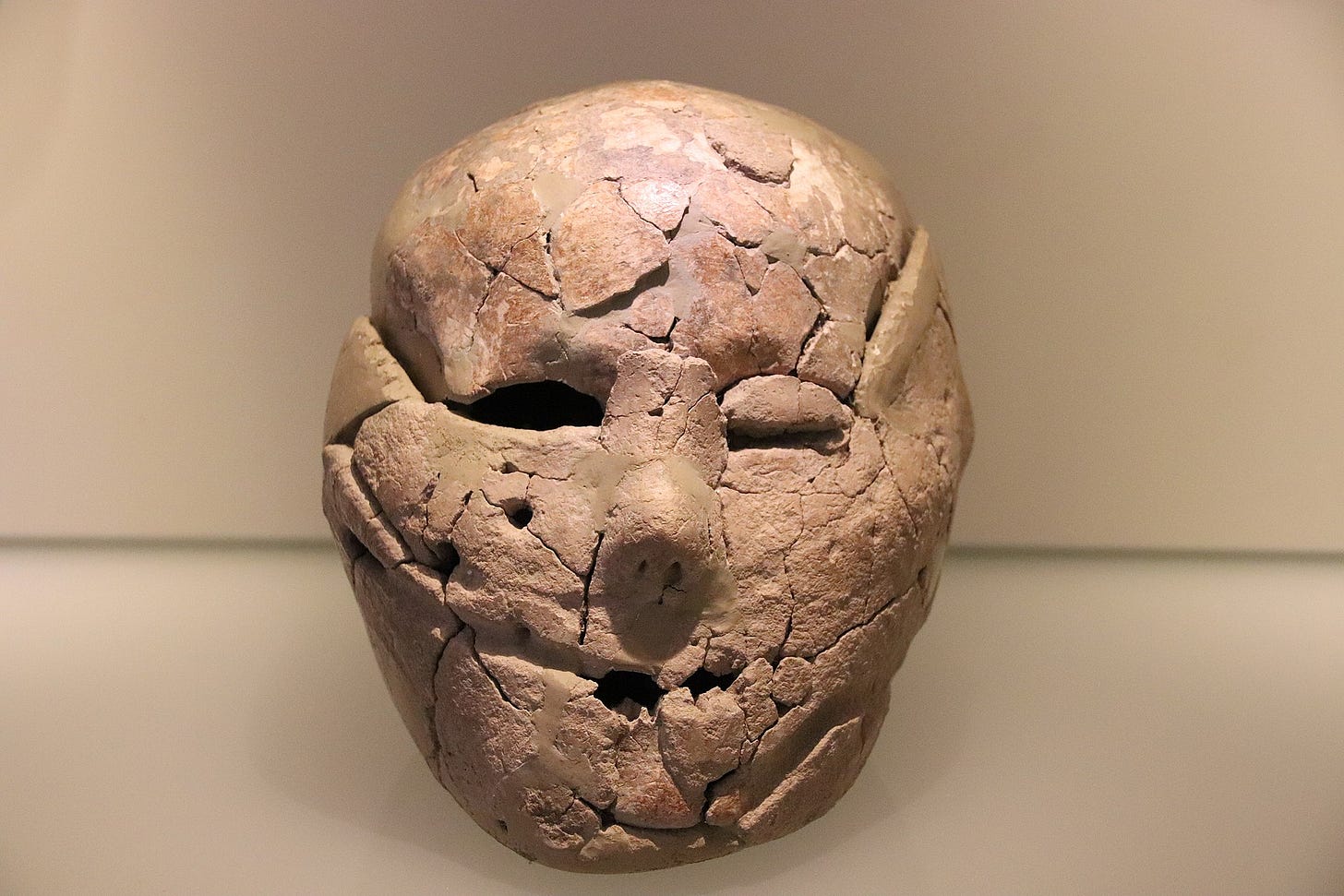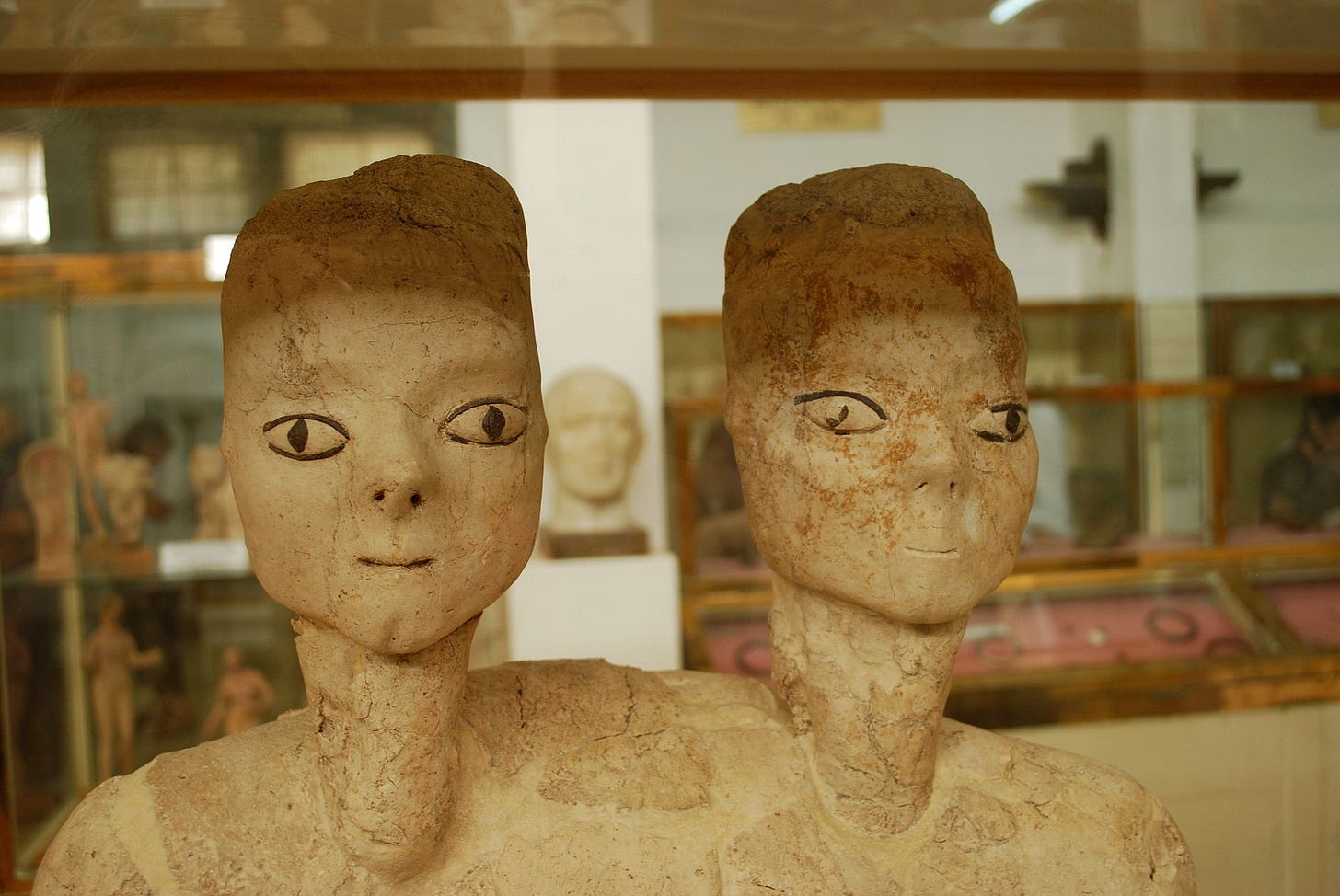Who Were the First Farmers?
The Origins of Agriculture
One of the oddities of the twenty-first century (and late twentieth before it) is that for essentially the first time in recorded human history, most of the people alive aren’t directly involved in food production. Agriculture is a specialized task, one that’s largely automated and optimized for maximum productivity (as opposed to diversity and resilience, taste, or employment). Not that many people in advanced economies are farmers today; in the United States, for example, only about two percent of the population is directly employed in agriculture. This frees up the vast majority of people to do other things, like writing email newsletters about prehistory, playing professional tennis, or working as a home healthcare aide. Craft specialization is predicated on agricultural surpluses: Everybody has to eat.
Our state of affairs is new. Even in the developing world, far fewer people work in agriculture than did fifty years ago. Global food transport networks allow for local and regional specialization in the types of crops most suited to those conditions, while fertilizers, pesticides, and genetic modification (among a myriad of factors) increase yields.
This wasn’t the case anywhere on Earth 200 years ago. Most people were directly involved in food production in some capacity, whether they were rice farmers in southern China, dairy farmers in the Netherlands, diversified homesteaders in western Massachusetts, or cattle-herders in Bantu-speaking Africa.
And for practically all of recorded human history - with writing, state systems, and much later, industrialization and the internet - the primary mode of food production has been agriculture. Most people living in advanced economies don’t even have to think about it.
But it’s a pretty weird thing, in long-term context. For most of the human past, stretching back hundreds of thousands of years, we’ve been hunter-gatherers, relying on wild flora and fauna for subsistence. That only changed after about 12,000 years ago, give or take a couple of thousand. In the intervening millennia, agriculture has transformed the face of the planet and allowed for an enormous explosion in the numbers of our species.
So we know that agriculture is a subsistence strategy that hasn’t existed forever, and which came into being relatively recently. We shouldn’t take it for granted - deciding to settle on a single patch of land and grow grasses or herd sheep isn’t a natural or straightforward thing for folks to start doing. How did it emerge? Where? And most importantly, why?
Properly answering those questions requires us to reframe them. In fact, we shouldn’t see agriculture as a binary, where you’re either a farmer or you’re not. Farming is a broad categorization for a wide spectrum of activities. Consider a nineteenth-century family of Appalachian homesteaders who grows some corn and keeps a few pigs, but who also hunts wild deer and other small game and collects wild fruit. Does that family consist of hunter-gatherers or farmers?
Instead of looking for a binary, we should be thinking about subsistence strategies and the management of resources. Farming is a way of managing a bunch of domesticated resources, whether they’re crops or animals, but people can selectively cull wild game populations or alter the landscape to favor the kinds of prey or wild plants they prefer. If we want to think about the beginnings of farming, we’re looking less for the flipping of a switch than a minute shift along this spectrum of activities. That means looking for a region rather than a single place, a broad period of experimentation rather than a defined origin, and fuzzy confusion rather than certainty.
Farming emerged in a whole bunch of different places around the world independently, with different complexes of domesticated plants and animals at different times. But we know where it happened earliest: the Fertile Crescent of the Near East, stretching north from Israel and Jordan into Syria and Turkey, then south into Iraq and the Zagros Mountains of western Iran.

In the few millennia after about 13,000 years ago, people living here began to preferentially exploit wild grasses like wheat and barley, legumes, lentils, and domesticated goats, sheep, pigs, and cattle. This basic package of domesticates then spread over much of Eurasia and Africa, and much later to the rest of the world.
This was a long, confusing series of processes. The Fertile Crescent 13,000 years ago was teeming with wild grasses - the ancestors of today’s domesticated grains - which could be collected in different places several times per year with a relative minimum of effort. The people who collected these grains even used specialized sickles, with a series of razor-sharp flint blades set into a bone or wooden handle.

Supplemented with wild gazelle and a few other food sources, the hunter-gatherers (more properly collectors) of the ancient Near East were a prosperous bunch.
More than 10,000 years ago, the hunter-gatherers of the northern Fertile Crescent came to a place in huge numbers (hundreds or more likely thousands) and carved elaborate limestone pillars. They decorated these pillars with carvings of vultures and other animals that had symbolic or ritual value to them. This is Gobekli Tepe, one of the oldest megalithic monuments in the world.

There are no signs of domesticated plants or animals at Gobekli Tepe. In fact, it took thousands of years for the tell-tale signs of domestication (larger and non-shattering grains, for example) to appear, mostly by accident rather than intentional selective breeding.

But even without the obvious signals of domestication, large communities (not just presumably temporary gatherings like Gobekli Tepe) started to appear in the Fertile Crescent. These people were probably intentionally cultivating grains that looked like their wild relatives, and exploited other wild resources. Their success at this way of life, however, produced an explosion in population numbers and much larger settlements - some of the first towns in human history.
One of these places was the settlement of Jericho in what’s now the West Bank of Palestine, about 10,000 years ago. Hundreds of people lived there, and they built walls (maybe for defense, more likely to prevent flooding) and even a tower. They developed a complex culture, probably one oriented around ancestor veneration. Building on a tradition that had existed among the hunter-gatherers of the Fertile Crescent, they buried the deceased under the floors of their homes and often kept the skulls of the dead visible, in circulation in the community. Plastering over the bone and impressing it with life-like features was a common practice. Here’s one of these plastered human skulls from Jericho:

There was clearly some sort of belief system and organizational structure at play. You can’t live together in large numbers without some way of understanding your place in the world and how you relate to other people, whether by descent or some other real or fictive form of group identity. This distinct, two-headed statue, found at the Jordanian site of ‘Ain Ghazal, might represent some real or fictive ancestors:

Over perhaps three thousand years, people living in the Fertile Crescent started growing grain and other plants. Perhaps a bit further to the east, toward the Zagros Mountains of Iran, other folks were tending the increasingly domesticated ancestors of sheep, goat, and cattle. Put together into a coherent package by about 10,000 years ago, it started to spread outward to the west and east, eventually reaching into North Africa, Europe, and Central and South Asia. This was a long way off, though, and the process was full of stops and starts, twists and turns, booms and busts.
As with the invention of farming in the first place, there were no straight lines or Eureka moments. People were just out there trying things, mostly with lesser rather than greater intentionality, hoping to make it from year to year and generation to generation. Accident and long-term experimentation, followed by rapid expansion and then usually collapse, defined the early course of agriculture. That’s where I’ll pick things up next time.
If you’d like to learn more about this, today’s episode of Tides of History, my podcast, covers the origins of farming in greater detail; this is the first of a bunch that will cover the Neolithic, as this phase is known, in global context.
If you’ve enjoyed this, please subscribe and share:
Further Reading:
James C. Scott, Against the Grain: A Deep History of the Earliest States
Stephen Shennan, The First Farmers of Europe: An Evolutionary Perspective
Graeme Barker, The Agricultural Revolution in Prehistory: Why Did Foragers Become Farmers?
T. Douglas Price and Anne Birgitte Gebauer (eds.), Last Hunters, First Farmers: New Perspectives on the Prehistoric Transition to Agriculture

These were the origins of agriculture in the Middle East. You mention there may have been several other origins but that most domesticated plants and animals came from here. What about those other large geographically separated agricultural regions from the Middle East? Did they receive the domesticated foodstuffs from here or develop their own? I’m also thinking about the Americas. Did any of these first domesticated foods or animals make it over with them? I think dogs must have but not sure about others.
In regard to Gobekli Tepe. What tools were used to make the carvings? How does one sculpt stone without metal tools? The level of cultural advancement required to have stone carvers/masons necessary to carve the block at Gobekli Tepe would seem to argue for a more articulated and advanced level of development that permits certain classes of people to devote time to carving sufficiently to develop artistic skills and earn a living off of it. Would this be a hint that there may be something we're missing or haven't found in the archaeological record?